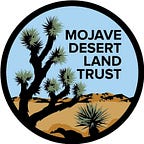Why we’re tracking beetles in the Mojave Desert
By Miranda Buckley, Women in Science Discovering Our Mojave intern
“I’ve got a friend-o!” exclaims Roseanna, who’s crouched over, peering intently at the crunchy leaf-litter scattered on my old white bed sheet that’s been laid flat in the sandy riverbed. I’m making the last sweep of our final sample from this stand of invasive tamarisk trees, so I finish up, twirl my net shut, and clamber across the deep sand to meet the little guy. “Nice!”, I holler as she spots another, “I want to get a good shot of these guys”. Making my way over, I see her meticulously sifted piles of tiny crunchy scale-like leaves; In the middle, three itty-bitty shapes wriggling wildly between the mounds.
I’m Miranda: WISDOM intern, lifetime Mojave resident, aspiring scientist, and shameless plant nerd. Though, on this day, I felt like a real-deal entomologist. In addition to tracking data on the comings-and-going of those lovable caprines, the bighorn sheep, we’re doing some exciting data collection on slightly less cuddly species that are shaking things up in Afton Canyon: Tamarisk Leaf Beetles, and the oh-so Splendid Tamarisk Weevils.
At our first stop every field day, we stomp to our site with big white bug nets swinging over their shoulders to execute a sweep-net sample. Biocontrol insects for the invasive tamarisk trees have made their way into the Mojave. These bugs feed on tamarisk salt cedars, which are guilty of crowding out native plants in the canyon, sucking up all the water, and making the soil around them salty when they drop their leaves. Did I mention that they’re nearly invincible? The insects we’re counting are from the exotic region that the trees are from, and they have evolved an exclusive relationship with them as food for their larvae.
The arthropods were intentionally imported and placed at a few study sites, where they were supposed to be contained. The bugs didn’t get the memo, though, and have been spreading across the southwest to riparian areas where tamarisk trees have been growing uncontrollably since the 1800’s. The beetles were discovered in Afton Canyon a couple years ago, but there’s not a clear picture about what their presence here means for the canyon’s ecosystem. That’s where we come in! As the sun rises in the morning over the Mojave on WISDOM field days, we sweep the branches and count whoever we find, and the condition of the tree to track the impact they’re making within Afton Canyon.
The other stars of our internship are those head-knocking, cloven-hooved bighorn. Females are often in groups, and have been spotted all around the canyon. One of the largest groups so far was recorded in July when three sheep were captured racing down the canyon while another four spectated. Last month, the ladies showed for the group discount at the salad bar in front of a field camera, looking fab-EWE-lous as always!
It’s important and exciting to be able to contribute to science and conservation this early in my career. I love field work, and with this project I’m able to learn and actively participate in tracking invasive plant control, as well as observe complex relationships first-hand as they happen in the Mojave.
After completing my undergraduate at Cal Poly Pomona next semester, I hope to focus my graduate work on understanding the ecology of the Mojave Desert. I want to make strong cases for conservation and improve restoration tactics, most of all, I hope to discover new things about the plants that live here and their interactions within this amazing ecosystem. The WISDOM internship has totally bolstered my enthusiasm and confidence as I progress toward becoming a field biologist. I’m so grateful to have had the opportunity to practice my knowledge in my favorite place on Earth, my home, the Mojave.
The Women in Science Discovering Our Mojave internship has provided new insights into the movement of bighorn sheep in the Mojave Desert, with game cameras collecting data and images of the elusive species. The internship expanded this fall with three new interns further tracking bighorn movement and gathering data on the tamarisk beetle.
This internship program is made possible through funding from Southern California Edison International.
For more news about WISDOM and other conservation work from the Mojave Desert Land Trust, subscribe here.
